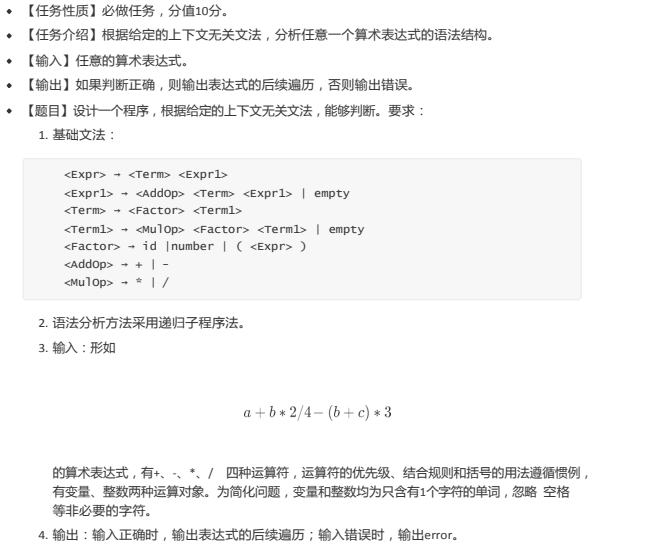
//抽象语法树
#include <iostream>
#include <algorithm>
#include <string>
#include <set>
#include <map>
#include <stack>
using namespace std;
string str;
bool is_right = true; //判断是否识别成功
char sym; //每次读入的字符
set<char> follow;
struct TreeNode{
string val;
TreeNode* left;
TreeNode* right;
TreeNode(string s) : val(s), left(NULL), right(NULL) {} //一个参数的构造函数
TreeNode(string s, TreeNode* l, TreeNode* r) : val(s), left(l), right(r) {} //多个参数的构造函数
};
int index;
TreeNode* Expr();
TreeNode* Expr1(TreeNode* arg1);
TreeNode* Term(TreeNode* arg1, TreeNode* op);
TreeNode* Term1(TreeNode* arg1);
TreeNode* Factor();
void error();
void init();
void postorder(TreeNode* root);
void inorder(TreeNode* root);
int main()
{
init();
//cin >> str; //读入算术表达式
str = "a+b*2/4-(a+b)*3#"; //"a+b*2/4-(a+b)*3#"
sym = str[0];
TreeNode* res = Expr();
if(sym == '#' && is_right)
{
cout << "success" << endl;
cout << "算术表达式抽象语法树的后序遍历结果是: ";
postorder(res);
cout << endl;
cout << "算术表达式抽象语法树的中序遍历结果是: ";
inorder(res);
}
else
cout << "fail" << endl;
return 0;
}
void init() {
follow.insert('+'); //定义Term1的follow集
follow.insert('-');
follow.insert(')');
follow.insert('#');
}
TreeNode* Expr() {
TreeNode* s1 = new TreeNode("");
TreeNode* term = Term(s1, s1); //第一次传两个空节点进去
TreeNode* expr1 = Expr1(term);
return expr1;
}
TreeNode* Expr1(TreeNode* arg1) {
if(sym == '+' || sym == '-')
{
string t = "";
t += sym;
TreeNode* op = new TreeNode(t);
sym = str[++ index];
TreeNode* term = Term(arg1, op);
TreeNode* expr1 = Expr1(term);
return expr1;
}
else if(sym != ')' && sym != '#')
{
error();
return NULL;
}
else return arg1;
return NULL;
}
TreeNode* Term(TreeNode* arg1, TreeNode* op) { //传进来一个操作运算符和一个运算对象
TreeNode* arg2 = Factor();
if(sym == '*' || sym == '/')
{
TreeNode* term1 = Term1(arg2);
TreeNode* res = new TreeNode(op->val, arg1, term1);
return res;
}
else //Term1产生为空,也就是sym是Term1的follow集
{
if(arg1->val.size())
{
TreeNode* res = new TreeNode(op->val, arg1, arg2);
return res;
}
else return arg2;
}
return NULL;
}
TreeNode* Term1(TreeNode* arg1) {
if(sym == '*' || sym == '/')
{
string op = "";
op += sym; //Term1产生的操作运算符
sym = str[++ index];
TreeNode* fact = Factor(); //返回的运算对象
TreeNode* res = new TreeNode(op, arg1, fact);
if(sym == '*' || sym == '/') //后面还是*或者/
{
TreeNode* res1 = Term1(res);
return res1;
}
else
{
return res;
}
}
else if(follow.count(sym) == 0) //+ - ) #,这些是Term1的follow集
{
error();
return NULL;
}
}
TreeNode* Factor() {
if((sym >= 'a' && sym <= 'z') || (sym >= 'A' && sym <= 'Z') || (sym >= '0' && sym <= '9'))
{
string t = "";
t += sym;
sym = str[++ index];
TreeNode* res = new TreeNode(t);
return res;
}
else if(sym == '(')
{
sym = str[++ index];
TreeNode* res = Expr(); //返回()内的抽象语法树的根节点
if(sym == ')') sym = str[++ index];
else error();
return res;
}
else
{
error();
return NULL;
}
}
void error() {
is_right = false;
}
void postorder(TreeNode* root)
{
if(root->left) postorder(root->left);
if(root->right) postorder(root->right);
cout << root->val;
}
void inorder(TreeNode* root)
{
if(root->left) inorder(root->left);
cout << root->val;
if(root->right) inorder(root->right);
}
四元式
#include <iostream>
#include <algorithm>
#include <string>
#include <set>
#include <map>
#include <stack>
using namespace std;
string str;
bool is_right = true; //判断是否识别成功
char ch;
set<char> follow;
struct quater{ //定义四元式
string result;
string arg1;
string arg2;
string op;
}quat[100];
int quat_index = 0;
void getQuat(string op, string arg1, string arg2, string result)
{
quat[quat_index].op = op;
quat[quat_index].arg1 = arg1;
quat[quat_index].arg2 = arg2;
quat[quat_index].result = result;
quat_index ++;
}
int tI = 1; //定义当前是t几了,比如t1,t2,t3;
string to_str(int a) //整型转变为string型
{
string s;
while(a) s += '0' + a%10, a /= 10;
return s;
}
string newT() //创建临时变量
{
int t = tI ++;
return "t" + to_str(t);
}
int index;
string Expr();
string Expr1(string arg1);
string Term(string arg1, string op);
string Term1(string arg1);
string Factor();
void error();
void init();
int main()
{
init();
//cin >> str; //读入算术表达式
str = "a+((b-c)+2)*3#"; //a+b*2/4-(b+c)*3#
ch = str[0];
Expr();
if(ch == '#' && is_right)
{
cout << "success" << endl;
for(int i = 0; i < quat_index; i ++)
cout << '(' << quat[i].op << ',' << quat[i].arg1 << ',' << quat[i].arg2 << ',' << quat[i].result << ')' << endl;
}
else
cout << "fail" << endl;
return 0;
}
void init() {
follow.insert('+'); //定义Term1的follow集
follow.insert('-');
follow.insert(')');
follow.insert('#');
}
string Expr() {
string res, arg1;
arg1 = Term("", "");
res = Expr1(arg1);
return res;
}
string Expr1(string arg1) {
string res, arg2;
if(ch == '+' || ch == '-')
{
string t = "";
t += ch;
ch = str[++ index];
arg2 = Term(arg1, t);
res = Expr1(arg2);
}
else if(ch != ')' && ch != '#') //ch不在Expr1的follow集中
error();
else return arg1;
return res;
}
string Term(string arg1, string op) { //传递过来的属性是操作运算符+或者-,运算对象
string res, arg2;
string arg3 = Factor(); //Factor产生的字符
if(ch == '*' || ch == '/') //Term1非空
{
res = newT(); //返回的中间变量
arg2 = Term1(arg3);
getQuat(op, arg1, arg2, res);
}
else //Term1不考虑错误,为空
{
if(arg1.size()) //传进来的arg1不是""
{
res = newT();
getQuat(op, arg1, arg3, res);
}
else return arg3;
}
return res;
}
string Term1(string arg1) {
string res, arg2;
if(ch == '*' || ch == '/')
{
string t = newT();
string op = "";
op += ch; //记录操作运算符
ch = str[++ index];
arg2 = Factor();
getQuat(op, arg1, arg2, t); //t是中间变量
if(ch == '*' || ch == '/') //非空
res = Term1(t);
else
{
return t;
}
}
else if(follow.count(ch) > 0) //ch是Term1的follow集
{
return res;
}
else if(follow.count(ch) == 0) //ch不在Term1的follow集 + - ) #, 一定出现错误
error();
return res;
}
string Factor() {
string res = "";
if((ch >= 'a' && ch <= 'z') || (ch >= 'A' && ch <= 'Z') || (ch >= '0' && ch <= '9'))
{
res += ch;
ch = str[++ index];
return res;
}
else if(ch == '(')
{
ch = str[++ index];
res += Expr();
if(ch == ')') ch = str[++ index];
else error();
}
else error();
return res;
}
void error() {
is_right = false;
}


这其实就是我们编译原理的作业,词法分析,语法分析,最后到语义处理
编译原理实验,相互学习。
可以问一下练习网址吗?